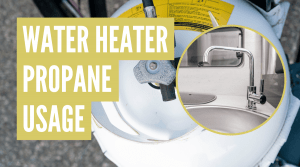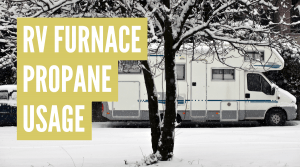Camper FAQs is reader-supported. Buying through links on our site may earn us an affiliate commission. As an Amazon Associate I earn from qualifying purchases.
Propane is a clean, portable source of fuel for many RV refrigerator models.
And if you’re boondocking, or have no electrical hookups, it might be your only source of power. So it’s important to plan your propane consumption accordingly.
But, how much propane does an RV fridge use?
Let’s look at how to accurately calculate your fridge’s propane usage along with some tips to make your fridge more efficient.
The Amount of Propane a Standard RV Fridge Will Use
The amount of propane your RV fridge uses depends on its age and size. Older models are less efficient. And typically, the larger the refrigerator, the more propane you’ll need to power it.
With that said, let’s look at a real-life example using the Dometic Americana 8 Cu. Ft. RV Propane Refrigerator.
The Dometic RV fridge with 8 cubic feet of internal space is rated at 1500 BTUs (British thermal units) per hour. One gallon of propane has 91,502 BTUs. So essentially you could run your fridge for roughly 61 hours off 1 gallon of propane.
How long you can run an RV fridge on propane will depend on the size of the tank. Your typical 20 lb. propane tank holds 4.6 gallons of propane.
So, how long will a 20 lb propane tank run a refrigerator?
Using the example above, we simply take 4.6 (gallons in a 20 lb. tank) X 61 (the hours our fridge will run off 1 gallon). You can run an RV fridge using a 20 lb. propane tank for 280 hours, or just over 11 days.
Tip: Check out our free propane usage calculator in our popular guide How Long Does Propane Last in an RV? to easily calculate the propane usage of all the appliances in your setup.
Now, let’s quickly look at how an RV fridge works, and then we can talk about how to maximize its efficiency. Because while we love the idea of remote RV use, we don’t want to carry, or burn through, more propane than we have to.
How a Propane RV Fridge Works
Your home fridge uses freon to keep food and beverages cold. But your typical RV fridge is different. It works using a combination of hydrogen, ammonia, and water. Together, they create a powerful evaporation effect that extracts heat and keeps things cool.
That sounds complicated, but it’s really not. Essentially instead of applying cold, an RV fridge works by extracting heat. That’s why it’s sometimes called an absorption fridge. It’s absorbing the extra heat, not creating cold temperatures.
If that doesn’t make sense, don’t worry. This step-by-step explanation might help.

- Propane heats the water and ammonia blend in a specially-designed boiler.
- The ammonia and water solution then travel to the separator, where the ammonia evaporates and continues through the refrigerators pipes and the water continues down to the absorber.
- As the ammonia vapors travel, they run into a condenser. The condenser extracts the heat and returns the ammonia to its liquid form.
- From there, the ammonia travels to the evaporator in the freezer element within your RV fridge and hydrogen is added to the ammonia. This mixture then moves to the evaporator in the fridge portion of the refrigerator. Any heat in the freezer and fridge portion is absorbed and passed to the exterior of the fridge, thus leaving the inside cool!
- Lastly, after passing through both evaporators, the ammonia enters the absorber and is separated from the hydrogen and mixed with the water before returning to the boiler.
Can I Make My Propane Fridge More Efficient?
Now that you know how your propane RV fridge works let’s look at ways to make it more efficient.
Routine Maintenance
The easiest way to improve your fridge’s efficiency is to make sure you’re keeping up with routine fridge maintenance.
- Disassemble and clean the LP gas burner
- Remove carbon deposits and dust from the flue and flue baffle
- Clean the ignitor assembly
- Vacuum and clean the cooling units and condenser fins
- Check the propane regulator for leaks and adjust accordingly
You don’t need to perform these maintenance tasks every time you use your fridge. Annually is fine. Make it a part of your camper de-winterization steps, for example.
Keep Things Level
An absorption fridge uses a system of fluids to keep things cool, as we discussed in the section above. That system relies heavily on gravity, which means it works best on level ground.
Important: If your RV isn’t level, your refrigerator won’t run as efficiently. And in worst-case scenarios, this can lead to mechanical issues.
Use a level before you start up your RV’s fridge every time! It could save you from major repairs and will maximize your propane.
Run Your RV’s Fridge Before You Pack It, Then Add Cold Foods First
Absorption fridges require time to cool down, sometimes a lot of it. In some cases, it can take as long as 24 hours for an RV fridge to reach the temperature you need it to be.
To help it along, try to let it pre-chill before you fill it full of food. And, when you do go to fill it up, add your cold items first. A few ice packs won’t hurt if you have space for it.
Cold food items will help the fridge lower its temperature faster, assuming you’ve allowed it to prechill for a few hours first.
Don’t Block the Rear
Typically an RV fridge will release heat air out the top vent and bring in cool, fresh air using a floor vent on the back of the refrigerator. If those vents are blocked in any way, your fridge will be far less efficient.
A blocked air vent is a common problem for RVers. For example, driving along bumpy roads can cause things to fall off counters, and sometimes those items land behind your RV fridge. Check and ensure that hasn’t happened when you go to set up camp.
You also want to ensure there’s space between the back of the fridge and your RV’s wall. This tends to be a problem if you’re installing a new absorption fridge.
Each model has different rear space requirements. And if your new model requires more space than the old one, you might be inhibiting its efficiency because of where you placed it. Check the manual and if needed, move your fridge a little further from the back wall of your RV to maximize efficiency.
Help Circulate The Air
RV refrigerators typically don’t come with a built-in circulation fan as your home fridge does. So, to help circulate the air and keep the inside cool you can install an RV fridge fan.
Simply attach the fan to your RVs fridge evaporator fins to help evenly distribute the cold air throughout the fridge.

15″ Triple Fan Deluxe RV Frost Guard Refrigerator Evaporator Fan
Price:Clicking this link to make a purchase may earn us a commission at no additional cost to you.
As an added bonus, the fan will help keep your RV fridge frost-free!







Write a comment